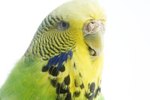
If you have a baby conure or a pair of conures ready to breed, you will want a nesting box. Making your own nesting box is fun, easy and rewarding once you see your baby conure or breeding conures make it their home. You do not want to provide a nesting box for an adult female, as this will trigger unnecessary and aggressive nesting behavior.
Using Plywood
You can purchase plywood from any local building materials store. If you do not have a saw, the store can cut the plywood for you for a nominal fee if you provide the measurements -- five12-by-12-inch sheets should do fine -- and one cut to measure 13 inches by 11 inches; you will use this piece for the top of the box. This piece will provide a slight overhang on the sides for securing the box to the cage and a 1 inch opening at the back of the box for an observation hole. Cut a 4-inch round hole in the center of one of the pieces so the bird can enter the box. If the store cannot perform this type of cut, you can use a drill with a round specialty bit or a jigsaw for this task. You will want to take a piece of sandpaper to the edges of the hole on both sides until smooth so that your conure doesn't get a splinter entering and exiting the box.
Time to Glue
Using wood glue, glue the pieces of your plywood together at the edges to make a box. For extra strength, you may hammer in finishing nails to secure the glue-setting process. Remove the finishing nails once the glue has dried overnight. When you glue the top piece on, make sure there is an overhang and that the gap is at the back of the box for the observation hole. The piece of wood with the hole cut in the center should be on the opposite side of the box from the observation hole. Sand down the outside edges of the box to minimize splinters.
Attaching to the Cage
You will attach the nesting box to the cage where there is an available opening. Most birdcages have multiple doors, so tying one open with a piece of yarn will do fine. Using strong wire, cut it into three pieces long enough to wrap around the box. The first piece will wrap around the top of the box with the overhand resting on it and be secured to the cage by twisting. The second piece should wrap around the center and attach to the cage level with the entry hole. The third piece should wrap around the bottom and be secured to the cage by twisting.
Nesting Materials
Some conures like to do their own "nesting." If you are providing a nesting box for a pair of conures, spread a little bit of newspaper, toilet paper or paper towels around the cage and the female will shred it and build her own nest. Some breeders recommend putting rubberized shelf liner on the bottom of the box; sometimes when the babies are moving about they push the bedding aside and have nothing firm to stand on. This can cause splayed legs and will hurt the baby birds. If you are building the nesting box for a young bird, you can fill it with soft bedding, shredded newspaper or clean straw. You will fill the box almost up to the entry hole.
Using a Cardboard Box
Since conures are not strong-billed birds, using wood is not necessary. A sturdy cardboard box works well too. Find a box that is similar to a 12-inch cube and tape the flaps shut. Cut two small holes at the top of the box, one on either side, to string a thick yarn through so it can be secured to the cage. Do this at the bottom as well. Cut a 5-inch entry hole in the front and an observation hole in the back at the top. Fill with nesting materials.
References
Resources
Photo Credits
-
Hemera Technologies/PhotoObjects.net/Getty Images
Writer Bio
Alana Krall has been writing professionally since 2008. Her work has been published in "North Valley Magazine," "Vancouver View Magazine," as well as online at VancouverBC.com, YoungEntrepreneur.com and other sources. Krall is currently pursuing a certificate in medical billing and coding.



